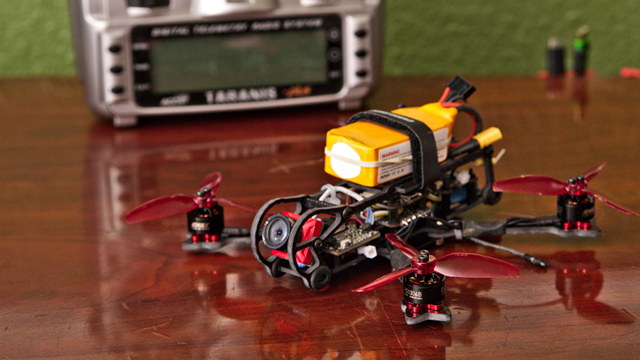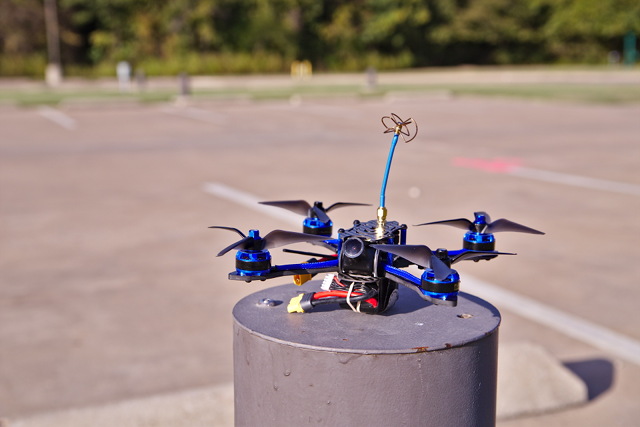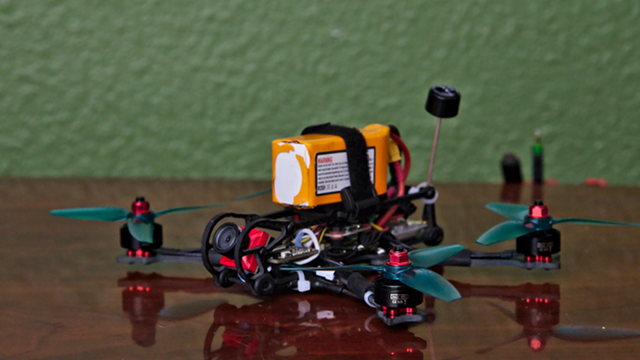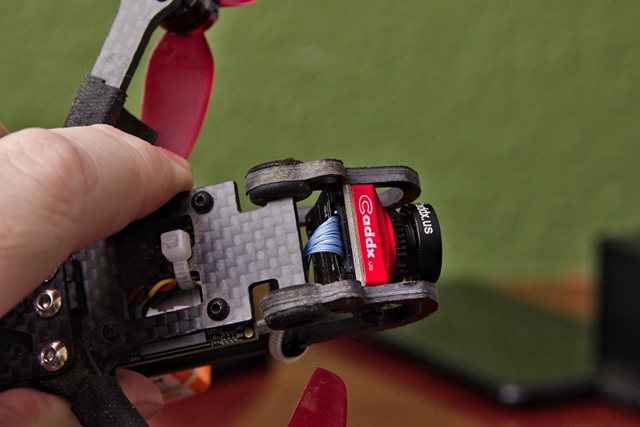When I started designing my Kestrel, I knew that I would have to experiment with 4” propellers. 4” props don’t get a lot of love, and that has been a problem. Lots of people fly 3” or 5” props, so there’s a huge selection of props. Since nobody flies 4”, there are only three or four props worth trying, and none are a great fit for what I’m hoping to accomplish.
What was I hoping to see?
I remember the first time I tried 6” props on my 5” quad. It had some fairly powerful 2600 kv T-Motor F40 Pro V2 motors. I figured it wasn’t going to work out well. Larger props need to spin slower, and those high-kv motors had me a little worried.
I quickly learned that it wasn’t a real problem. If my memory serves, I was getting roughly 30% longer flight times compared to 5” props. This was true whether I was doing slow, cruising, long-range-style flights, or punchy freestyle flying.

When flying 6”, you will see a lower top speed compared to 5”, but you’ll gain a ton of grab in the air. If you’re falling out of a long dive, the 6” props can just catch you like nobody’s business.
Math and pi tell us that a 4” prop has a disc area that is 77% larger than a 3” prop, while a 6” prop only has 44% more surface area than a 5”. It is a bigger difference, but I was hoping to see the same sort of changes: longer flight times, more bite on the bottom end of the throttle, and lower top speeds.
Can we build a sub-250-gram 4” freestyle quad with an HD camera? Will flight times be long enough for some long-range flights? Will it feel more like a 5” freestyle quad?
My testing with 6” had me concerned
A bunch of us own an old Bind-N-Fly miniquad from Aurora RC called the BFight 210. We all loved it. I got my first one free as a review unit. I immediately bought another for my nephew. Several friends also bought them. It was always going on sale for $120 or less, and we all bought them during sales. It was a tremendous value.
It wasn’t a speed demon, and it felt terrible if you tried carrying a GoPro. I believe it had 2205 2300 kv motors. New pilots were regularly seeing 9-minute flight times. My record on a long-range style cruise was over 11 minutes. How amazing would the BFight 210 be with 6” props?!

It was terrible. The 2204 motors just didn’t have the power to handle such a big prop. It felt terrible, and flight times didn’t improve. In hindsight, this isn’t surprising. At the time, it was a bummer.
4” props on a 270-gram Kestrel
I missed the 250-gram mark with my 4” Kestrel build, but I know I could bring it down and save a few dollars doing it. I used the beefy Aikon AK32PIN 20x20 blheli32 4-in-1 ESC, and I used a big 1,000 mW VTX. If I switched to a Diatone Mamba F4 20x20 stack, a 200 mW VTX, and maybe pulled back from a 650 mAh to 550 mAh 4S battery, I’d save $40 and easily shave 20 grams off the build.

There are tons of 4” props available, but most of them are for airplanes, and many of the rest are ancient, inefficient bullnose propellers. The best props I’ve found to pair with my little EMAX 1606 2800 kv motors so far are the HQ 4x3x3. I’m aware of the new EMAX Avan Scimitar 4x2.4x3 props. I plan to throw a few into my cart the next time I’m ordering miniquad supplies!
UPDATE: I did order some EMAX 4x2.4x3 props!
I have to say that overall, I am mostly pleased with the way my 4” Kestrel build flies. It feels more like a 5” freestyle quad than any 3” I’ve flown. I feel more confident coming out of sketchy split-S maneuvers or power loops that just weren’t lined up well.
That was the good news
Propwash handling is terrible with this combination. Mark Spatz has an excellent video explaining why gentle props on powerful motors make it much easier for your Betaflight to fight propwash, but I can’t seem to figure out exactly which video that is! I have relatively big, heavy props on relatively tiny motors.
Sure, I can fly around this propwash, but I always forget that I need to. I try to fly it like it is my 5”, and that doesn’t work out.
I’m also not seeing any real gain in efficiency. My 220-gram 3” Kestrel with 1306 motors usually manages 4 or 5 minutes of the sort of freestyle flying that I tend to do. The 4” rarely makes it past 4 minutes.
When I’ve purposely taken slow, boring flights with the 3” Kestrel, I’ve pushed past 8 minutes of flight time. I’ve never managed more than 6 minutes with the 4” Kestrel.
That said, I’m willing to give up that extra minute of flight time. My 4” Kestrel feels much more like a 5” freestyle quad than my 3” build!
The Caddx Turtle is just awful
The first obvious problem with the Turtle or Split is that the HD video and FPV video settings are tied together. There’s only one sensor on that camera. That means ISO and shutter speed are shared, and the settings that make the HD feed look reasonable make for a poor flying experience.
The field of view on the Turtle is tiny compared to a GoPro with SuperView. That’s always a disappointment.
NOTE: I’m sorry. I rarely upload Caddx Turtle video, because I just dislike it so much. The video I embedded here looks kind of hokey, I think. Maybe I need to start uploading my vlogs in 60 fps when flying with the Turtle?
The Turtle produces serviceable HD footage when you’re flying slow and just cruising. Once I start doing quick, snappy moves, I’m disappointed with the video. I just can’t get enough motion blur into the image, even with an ND filter. It just looks like a slideshow. I don’t like it.
These cameras are getting better every few months. The Caddx Tarsier and the Runcam Split Hybrid both look like a huge steps in the right direction.
What can we do if 4” props are too heavy?
I’d really like to try a biblade version of the HQ 4x3x3. I even emailed HQ to ask if they had anything like that. The response was confusing, so I’m going to assume this won’t be an option.
The plan was to cut me a set of bullnose 3.5" props from a set of 4" props. I measured wrong, and made a completely useless set of bullnose 3" props! pic.twitter.com/mHLbDQQLX4
— Pat Regan (@patsheadcom) September 23, 2019
I decided to take matters into my own hands. I dropped my heavy vise onto the bed of my Shapeoko CNC machine, and I clamped in one of my old 2306 motors. I positioned the router about 1.75” away from the center of the motor, and I manually cut down some of my HQ 4x4.3x3 and HQ 4x3x3 props.
This worked surprisingly well!
I don’t have a lot of data on 3.5” props
I’ve flown two batteries so far. They weren’t even fresh batteries. They’ve been sitting in my bag at full charge for the better part of a month. They fly just fine, but I don’t feel comfortable comparing efficiency to what I used to see on freshly charged batteries.
These cut-down props are now bullnose props. Bullnose props should be significantly less efficient than a properly designed 3.5” prop. We don’t have any of those to compare with, though. A 3.5” prop has 36% more disc area than a 3” prop, so this is much closer to the upgrade from 5” to 6” props.
I can tell you that the huge propwash problem is almost completely gone. Like with any quad, if I try my hardest, I can definitely coax some propwash oscillation out of the 3.5” bullnose props. I know for sure that I hit some accidental propwash at least once, but it wasn’t as bad, and it would have been easy to avoid.
I’m going to have to do some back-to-back testing. I need freshly charged batteries. I need to fly some 3”, 3.5”, and 4” props. I need to fly more than one battery on each prop, too.
In any case, I’m pretty excited.
Shaky video on my 4” Kestrel
I’ve been cutting Kestrel frames for my friends, and I don’t really enjoy spending a ton of time in the garage cutting carbon fiber; it is too hot out there!
That means my two Kestrels are built using my oldest parts. Most of the magic on the Kestrel happens where the bottom plate meets the rubber suspension. I have to size that tab just right. Too small, and it just wobbles around. Too large, and the suspension doesn’t absorb vibration. This has been tweaked a bit on almost every bottom plate I’ve cut.
On top of that, I’ve also redesigned the bottom plate to make it more rigid. Of course, my two Kestrels use old bottom plates. My tabs aren’t quite the right size, and my bottom plate is much less rigid.
I noticed that my 4” Kestrel’s fuselage can be twisted quite easily. I figured my less-rigid bottom plate was weakening in all my crashes, and it probably is, but I also learned that the McMaster-Carr grommets get soft and deformed over time. I swapped some new grommets in, and that helped a lot.

It is still looser than I would like.
Here’s the bummer. I swapped out the grommets and swapped from 4” to 3.5” props at the same time. Did the stiffer grommets correct the problem? Are my 3.5” props just a little unbalanced? They have to be a little out of balance, right?
I’m due to cut myself some up to date bottom plates. I’m just not looking forward to disassembling the entire Kestrel to replace one plate!
9 months flying HD micro freestyle quads
In many parts of the world, there’s a 250-gram weight limit on model aircraft. I’m not too worried about this today, but it sure seems like the same sort of rule will be coming here, too. I think it is prudent to be testing the waters.
I also love the idea of having a hold-my-beer quad. When I’m flying my 3” Kestrel, I can record HD footage, and everything in the air costs around $250. That’s including the battery. That’s somewhere between the cost of a GoPro HERO5 Session and a HERO7 Black.
Sure, the quality isn’t nearly as good as a GoPro, but I also won’t feel as bad when my Kestrel gets stuck on a roof or sinks to the bottom of the ocean.
That seems to be the only time I would really want to fly one of my 3” or 4” micros. My 5” Falcon freestyle quad flies better, records better footage, and I’m rarely worried about the possibility of losing the whole thing.
On the other end of the spectrum, if the spot that I’m flying isn’t a good fit for my 5” freestyle miniquad, I’m probably not going to fly a 3” either. There’s a much better chance that I’ll be monkeying around with my minuscule EMAX TinyHawk Freestyle if there’s likely to be people or delicate property nearby.
I keep saying that things are constantly improving. By the time the United States has a 250-gram weight limit, maybe the successor to the Caddx Tarsier will be as good as my GoPro Session. I’m sure Betaflight will continue to improve. Motor and prop selection for micros will only get better.
Until that time, my 3” and 4” Kestrels will be relegated to occasional flying.
Is the rubber suspension required? Is it even helpful?
This is the real question. I decided to use the Acrobrat-style suspension on the Kestrel, because it sounds like an excellent idea. Does it really help?
My honest answer has to be that I have absolutely no idea! Maybe there should be a 3” and 4” version of my open-source Falcon frame? That would be a good way to test the effectiveness of the suspension.

I hope that the suspension is helpful. Maybe a fresh build with brand new props doesn’t need the rubber bushings at all, but what happens when you bump a tree? Will the bushings save your footage?
If the bushings would save my footage after some slight prop damage, they’d be worth the additional hassle!
Hardware problems in my 3” and 4” Kestrels
I broke my 3” Kestrel a long time ago. I got stuck in a tree, and had to use turtle mode quite a lot to wiggle it loose. It was stuck quite well, then it fell down a few branches, and got stuck again, and then a third time. When it finally hit the ground, the Caddx Turtle was dead. It wasn’t dead when I started my attempt to recover the poor thing.
It hasn’t flown quite right ever since. It’ll fly OK if I add a ton of filtering, so I haven’t made the effort to fix it. The new revision of the Diatone stack is only $38, but I didn’t really want to take everything apart and resolder every connection!
I soldered an old motor to my 4" Kestrel to verify that I do indeed have a busted ESC. Yes, I do indeed have a very busted ESC. pic.twitter.com/3ZRa366wsc
— Pat Regan (@patsheadcom) October 3, 2019
Last week, an ESC on my 4” Kestrel failed. This is both a surprise and a bummer. I chose a relatively expensive and heavy ESC board for that build. I figured that an ESC that folks are using in 5” racing builds with 2207 motors ought to be bulletproof on my tiny 1606 motors. It wasn’t.
The smart, frugal thing to do would be to replace the ESC board with the little Diatone ESC. I’m not going to do that.
I ordered a pair of Diatone Mamba stacks, and I’m going solder them into both my Kestrels next week. Sure, the Diatone F4 flight controller is a downgrade from the F7 board that is currently in the 4” Kestrel, but I like the idea of them running the same inexpensive hardware.
I’d like to be able to point to either of them and say that you could build either for around $250 or less!
I’ll use this repair opportunity as an excuse to cut new bottom plates for my Kestrels. I have the oldest prototype plates in mine, and they have extra material cut out to make them lighter. That also makes them quite a bit softer. It is time to bring my own builds up to match everyone else’s!
Conclusion
I’ve used quite a lot of words just to explain that I’m excited about trying 3.5” props. That’s really all I’m here to say today. I’m excited about 3.5” props, but I don’t have much solid data to give you at this point. I’ll fly some more over the next week or two, and we’ll see what I find out!
What do you think? Have you tried 3.5” props? Are you flying 3” or 4” props? Do you think splitting the difference is interesting? Let me know in the comments, or stop by the Butter, What?! Discord server to chat with me about it!